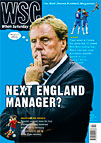 To commemorate the 300th issue of WSC here are a few notable moments from our history, along with some WSC trivia
To commemorate the 300th issue of WSC here are a few notable moments from our history, along with some WSC trivia
A new issue had just been unloaded from the printer’s van. We opened one of the bundles, each of which had been covered with a sheet of paper. On the front cover, where a picture of Graham Taylor is supposed to be, is a close up of a studded black leather boot with an enormous heel. It is Skin Two, an S&M magazine. A phone call to the printers confirms that the wrong bundles had been loaded on to the van. A few miles away, Skin Two staff unwrap their new issue, stare at Graham Taylor and wonder if they have gone too far this time.
The film company making Catwoman, starring Halle Berry, requested some copies of WSC for use as props in a scene in which one of the supporting cast, a keen footballer, is seen at home reading magazines. We subsequently sat through the film, one of the biggest Hollywood flops of recent times, but there was no sign of WSC, even in a wastebasket. There might be a great big close up in one of the deleted scenes on the DVD but we can’t face it.
When WSC first began to take advertising in 1990, Roy of the Rovers was still being published as a weekly comic. One of our staff phoned the publishers to ask if they would be interested in taking out an ad. It was a crackly line so he had to shout: “Hello! Is that Roy of the Rovers?” A weary voice at the other end, used to dealing with keen young fans, said slowly: “No, Roy’s not here at the moment but if you’d like to leave a message for him, we’ll pass it on.” We didn’t get the ad.
We received a phone call about an article on Mansfield that had appeared in a WSC series called Five Minutes in 2002. Was the caller right in thinking it had mentioned Keith Cassells? It had. Cassells – “a stylish striker whose goals won us promotion in 1986” – had featured as the writer’s hero. Could they buy it over the phone? Yes, they buy three copies and pay with a credit card? So we asked for the card number, then the name. “It’s Keith Cassells, spelt C-A-S…” We sent the copies for free. This is similar to the “JR Hartley” Yellow Pages ad, but heart-warmingly real.
Former Culture Secretary Andy Burnham MP is the only WSC contributor – three Everton-related articles between 1995 and 1997 – to have become a member of the cabinet. As far as we know.
The figure on the cover of WSC comes from a 19th-century advert included in a sample of facsimile documents called the Jackdaw Football Collection, which was published in the early 1970s. We have a lifesize cardboard cutout in the office, which was made for a book launch in the early 1990s. The publishers initially made a six-inch-high version, due to a series of misunderstandings reminiscent of the mini Stonehenge incident in Spinal Tap. The lifesize figure has a damaged neck, reinforced with tape. His head sags noticeably when sales are down.
In the late 1980s we employed people to sell WSC outside grounds on matchdays. It could be a hazardous business. One of our student helpers was approached at Stamford Bridge and asked if WSC was “anti-fascist”. He replied that it was and his questioner shouted “You bastard!” and attempted to punch him in the face. The oldest seller, a man in his 70s, was also the most successful and would often collect several bundles of the latest issue. Once we happened to see him in action outside Upton Park, where he was loudly touting WSC as “the Guardian for lager louts”. Although this seemed to be working, we had to ask him to try a different tack.
WSC was mentioned in Coronation Street in 1991. The mother of one of the McDonald twins asked him where his brother was, to be told: “He’s taken his copy of When Saturday Comes and gone to read it in the toilet.” This may not have been intended as a comment on the contents. Granada declined to accept copies of WSC for the newsagents The Kabin.
WSC‘s TV debut was on an edition of Saint & Greavsie in February 1989 when the reporter Peter Brackley visited our tiny litter-strewn room in an office belonging to Islington Council. When they cut back to the studio, Ian St John said something like “That’s the lads there” and moved quickly on. This was recorded but we can’t find the video and, unsurprisingly, it hasn’t made its way onto YouTube. If you were in the habit of taping Saint & Greavsie in that era, you really shouldn’t have done. But if you did, let us know.
From WSC 300 February 2012